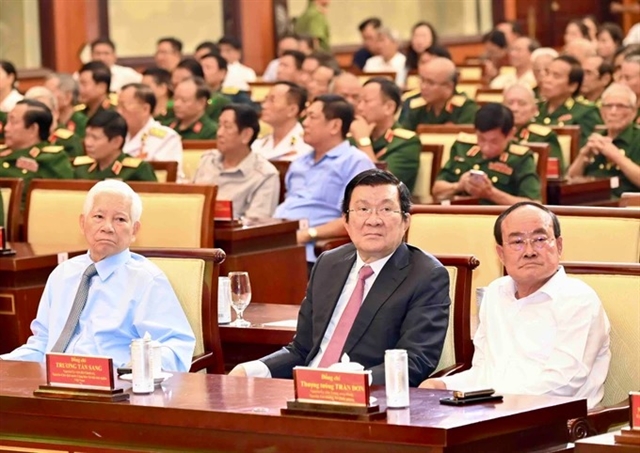 Op-Ed
Op-Ed

After 30 years of the Đổi mới (Renewal) reform, Việt Nam has recorded significant achievements in socio-economic development, lifting nearly 30 million people out of poverty. However, increasing income and wealth inequality is threatening the progress made in decades.
 |
Babeth Ngoc Han Lefur
After 30 years of the Đổi mới (renewal) reform, Việt Nam has recorded significant achievements in socio-economic development, lifting nearly 30 million people out of poverty. However, increasing incomes and wealth inequality are threatening the progress. Oxfam in Việt Nam’s Briefing Paper, “Even it Up, How to tackle Inequality in Việt Nam”, calls for urgent action – through the implementation of progressive policies on governance, taxation, public spending, public services, labour rights and civic engagement – to address inequality in the country. The paper, which will be launched to coincide with next month’s gathering of many of the super-rich at the annual World Economic Forum in Davos, asserts that unless inequality is addressed, Việt Nam may not achieve Socio Economic Development Plan 2016-2020, Sustainable Development Goals (SDGs), and may become stuck as a middle income country.
The problem of inequality in Việt Nam is taking place in the context of an unprecedented inequality crisis across the globe. In 2015, just 62 people had as much wealth as the poorest half of humanity, and the richest one per cent owned more wealth than the rest of the world combined. The same is true in Asia, where the income of the poorest 70 per cent has decreased, while the richest 10 per cent has seen significant gains. Asian Development Bank research estimated that 240 million more people in the region could have been lifted out of extreme poverty in the past 20 years, had inequality not increased.
Inequality in Việt Nam is on the rise. Although the country’s net household incomes have increased in the last few years, the rate of increase has been faster and greater among the wealthy. The number of extremely wealthy has skyrocketed. In 2014, while 12.3 million people were living in poverty, there were 210 super-rich individuals (those with more than US$30 million) in Việt Nam, and their combined wealth was around $20 billion; equivalent to 12 per cent of the country’s GDP. These 210 super-rich earn enough in one year to lift 3.2 million people out of poverty and end extreme poverty in Việt Nam. Knight Frank estimates there will be a considerable increase in the number of these super-rich individuals in Việt Nam; rising to 403 by 2025.
Oxfam research in Lào Cai, Nghệ An and Đắk Nông- three provinces with populous ethnic minorities- shows that income disparity between 20 per cent of the richest households and 20 per cent of the poorest households is 21 times. Nationwide, ethnic minorities comprise only 15 per cent of the Vietnamese population, but account for 70 per cent of its poorest.
Experts tout Việt Nam as a success story in alleviating poverty and have urged the country not to rest on its laurels. In 2013, the country experienced its lowest rate of GDP growth in 13 years (5.03 per cent), as a result of macro-economic instability and external shocks. As this happens, the challenges generated by the income gap are likely to worsen.
Income inequality is only one side of the coin. Inequality in voice and opportunities is another serious challenge in Việt Nam. Research from the World Bank and Oxfam shows that inequality of opportunity is the most worrisome form of inequality in Việt Nam, particularly among rural and poor people. Among 15 million migrants, many are excluded from accessing basic services (education, health), employment and social protection. Girls, ethnic minorities and the poorest are disproportionately excluded and under-served. Women are disadvantaged in their ability to access education and to advance their capacity. Despite their huge numbers, female workers are mostly unskilled and untrained, working in labour-intensive sectors such as footwear and textiles (78.5 per cent), food manufacturing and processing (66.8 per cent), porcelain and glass (59.2 per cent).
Children from the poorest households have seen little to no improvement in educational outcomes in the last 20 years. The following story shows how poor people struggle with difficulties in education:
Uyên is a 16-year-old Mường girl who stopped her studies after finishing eighth grade. Her mother had thought hard about which child to keep in school, and had pulled Uyên’s older sister out of school at ninth grade to save money for Uyên to continue her studies. However, Uyên’s sister proved to be a strong role model for Uyên, who later decided that she would also stay home to help her mother.
Uyên’s story is a reflection of public services’ weakness. While the national budget for education is high, fees continue to act as a barrier to the poor accessing quality education. A 2013 survey identified 15 major groups of fees, and estimated that 30 per cent of education spending is paid for by families through out-of-pocket payments. In health care, while health insurance coverage has increased, a large proportion of total health spending – nearly 50 per cent – is still paid out of pocket, pushing millions of people back into poverty (above 400,000 households in 2012).
Rising inequality is bad for everyone. It may hinder the ability of lower-income children to reach their potential. This means not only a lower level of social mobility, but also a slower rate of future growth for the economy. Inequality is a barrier to poverty reduction but it can also lead to social unrest. In China the crime rate is found to be positively correlated with intra-provincial regional inequality; and an increase in income inequality has a robust effect of increasing crime rates. Việt Nam may not be immune from such a trend. Crime rates have shown no sign of abating, and crime is increasing among young people. This highlights the growing unwillingness of people to accept the disproportionate benefits of national economic growth.
Rising inequality goes together with rising corruption which tends to make the poor poorer and the rich richer. The benefits from corruption are likely to accrue more to the better-connected individuals in society, who belong mostly to the high income groups. It is the poor in society that are often hardest hit by the effects of corruption. In 2014, Việt Nam ranked 119th globally in Transparency International’s annual survey of perceived corruption.
Inequality concerns all people including leaders worldwide. In a speech in 2013, US President Obama described rising income inequality as the "defining challenge of our time." Chinese leader Xi Jinping has stated multiple times that closing the inequality gap must sit alongside the goal to raise GDP. In the wrap-up speech at a regular meeting of the Việt Nam Party Central Committee, Communist Party General Secretary Nguyễn Phú Trọng stated that the wealth gap is only widening and poses the most worrying threat to the survival of the political regime, and he added "The rich-poor divide" [only] shows signs of getting worse”.
In September 2015, the United Nations adopted the 2030 Agenda with 17 SDGs. Reducing inequality, for the first time, is among the global goals. Vietnamese then-President Trương Tấn Sang attended the conference and confirmed that the Vietnamese State is committed to mobilising all resources, all ministries, localities, institutions, communities and people to successfully implement the 2030 Agenda and the SDGs.
To ensure that the next 30 years sees continued improvement in the lives of the poorest people, the government must take all forms of inequality into account – income, opportunity and voice inequality. The government should also analyse its policies to understand their impact on inequality and commit to a new programme of action, and progressive policies. This means improved governance and accountability, as well as ambitious commitments to fairer taxation, public spending, public services, and improved labour policies. This will not be possible without improving the voice of disadvantaged groups through participatory structures and improved forms of accountability. The right combination can fight poverty and inequality for the next generation.
*Babeth Ngoc Han Lefur is the Country Director of Oxfam in Việt Nam.









